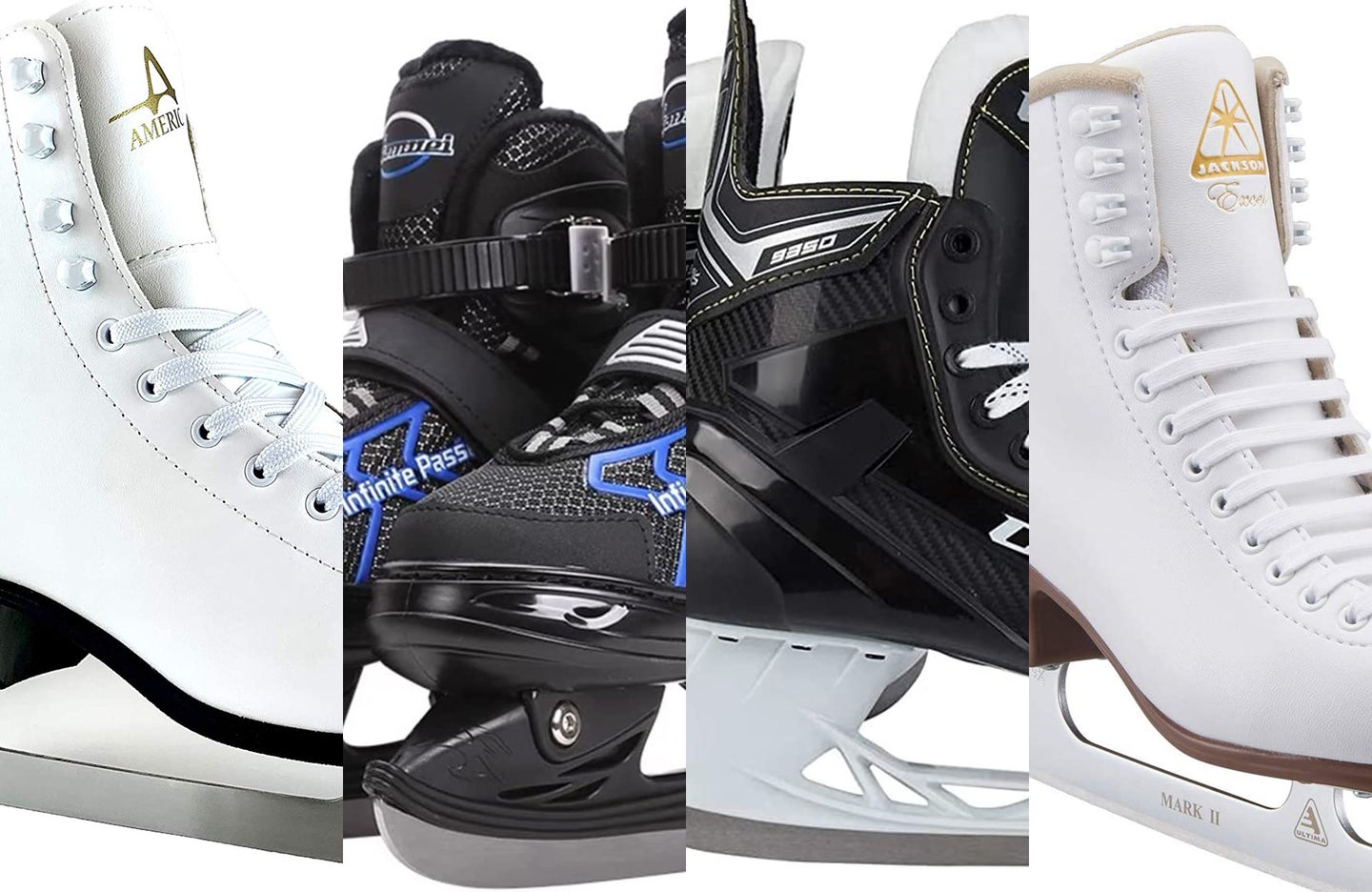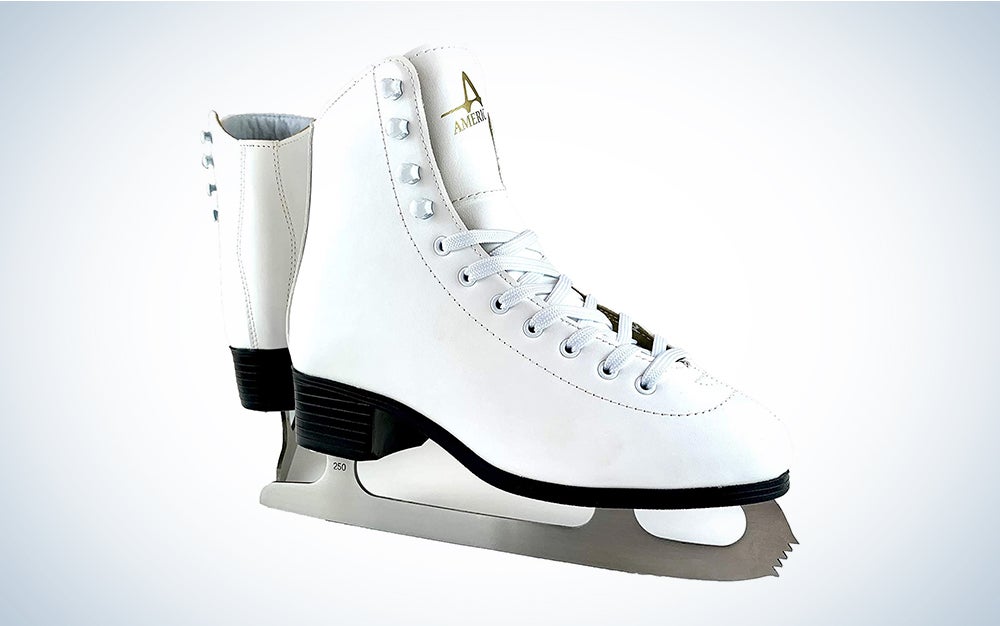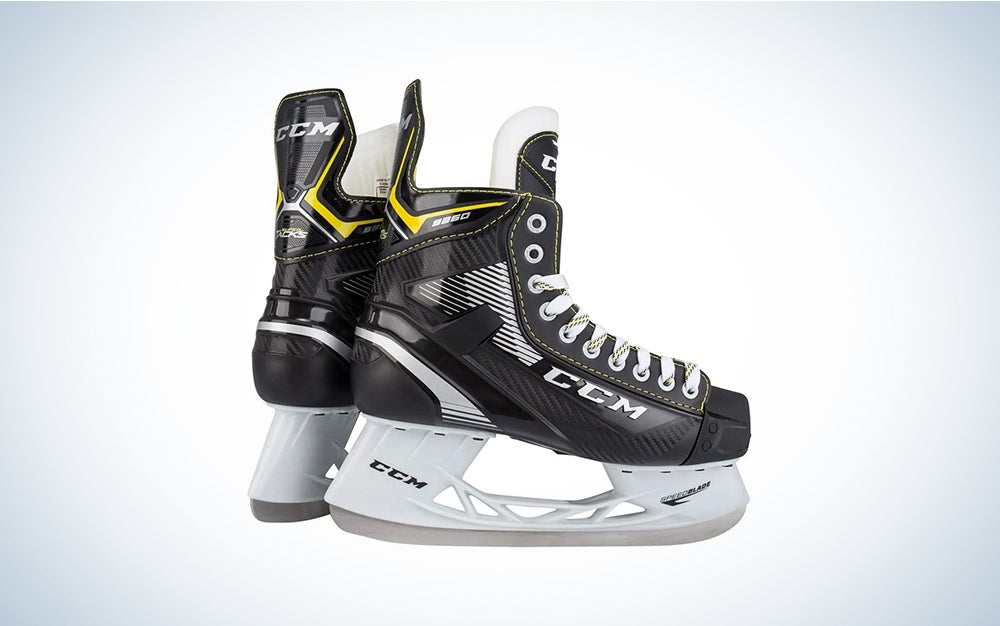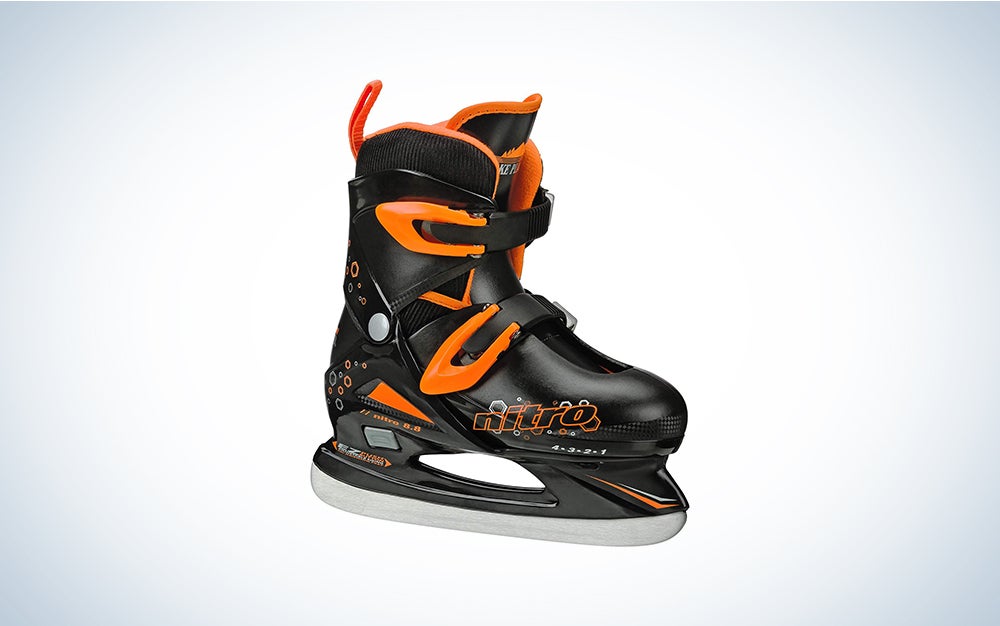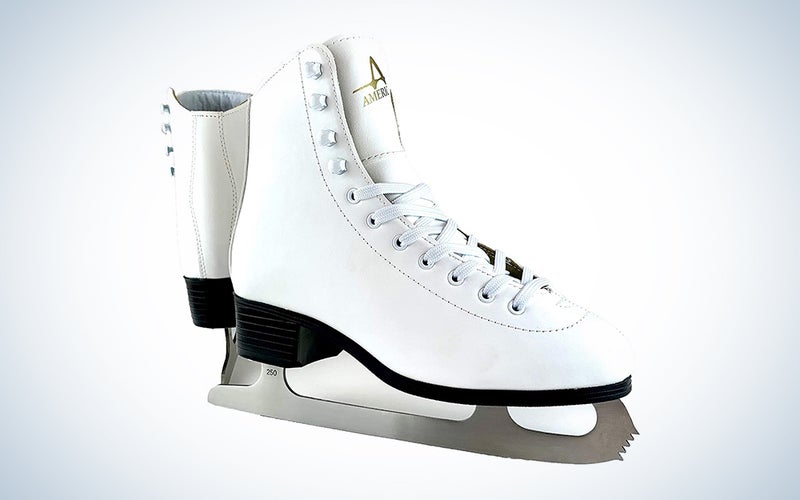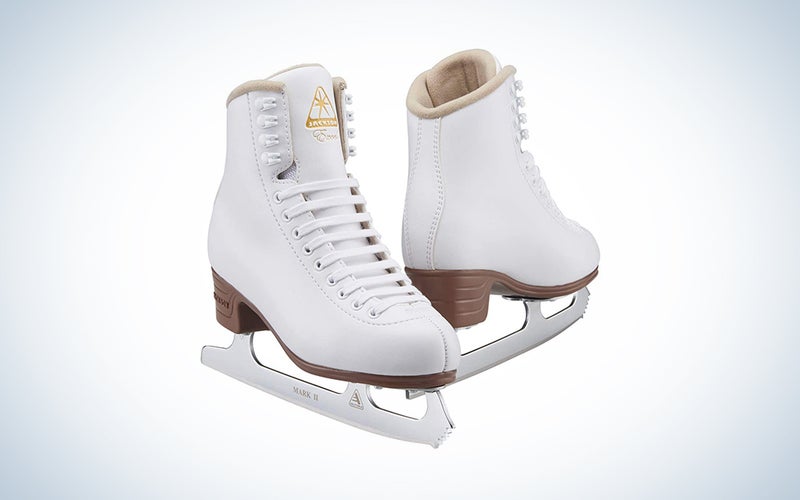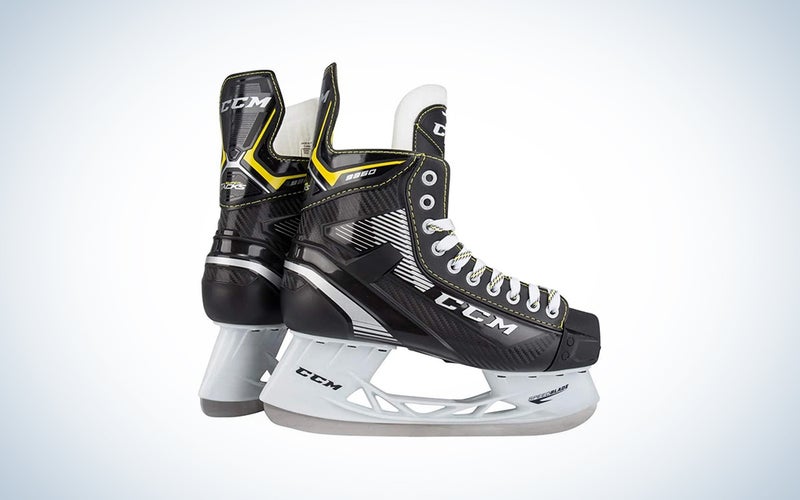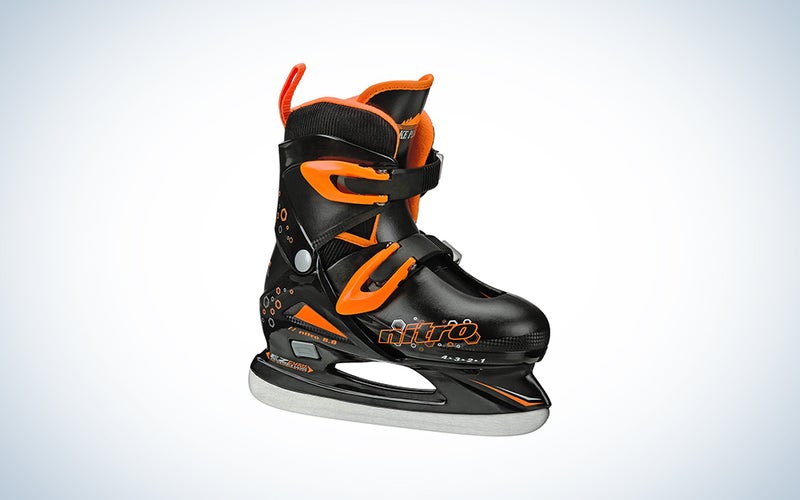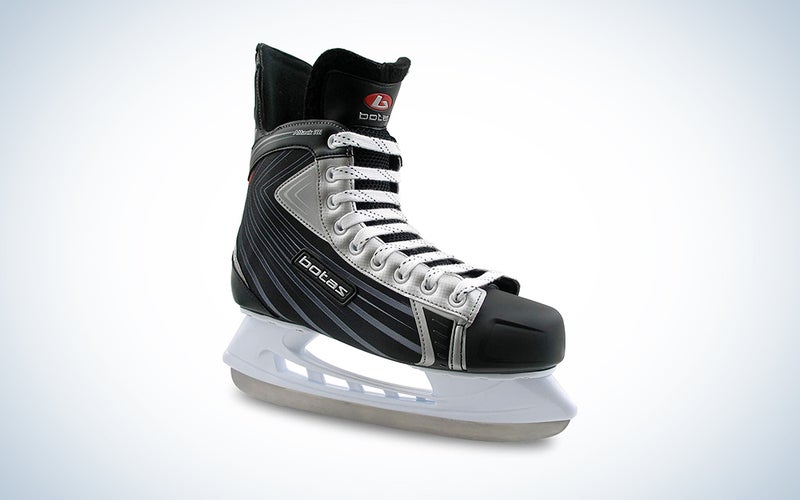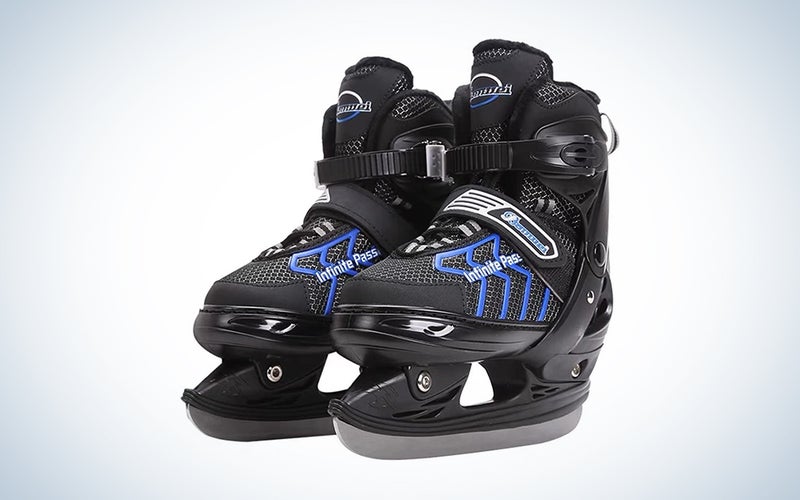We may earn revenue from the products available on this page and participate in affiliate programs. Learn more ›
Finding the best ice skates is similar to shopping for any kind of specialized sports equipment. You have to know your intended use: Are you a speed skater, a figure skater, a hockey player, or just a recreational skater? You also have to understand how skates fit. It’s not the same as shopping for a pair of sneakers or work boots, so it’s important to grasp the intricacies of skate design and intention because it could mean the difference between a smooth trip around the rink and a painful round of crippling foot torture. The best ice skates are comfortable, provide great ankle support, and make ice skating as smooth as … ice.
- Best overall: American Athletic Ice Skates
- Best for figure skating: Jackson Ultima Excel Women’s Figure Skate
- Best for ice hockey: CCM Super Tacks 9360
- Best for kids: Lake Placid Nitro 8.8
- Best for adult beginners: Botas Attack 181
- Best budget: DUWIN Adjustable Ice Skates
How we chose the best ice skates
Evidence suggests that the notion of ice skates skimming across frozen ponds or lakes first occurred to the people of Finland more than 4,000 years ago. Since then, ice skating has evolved from a practical means of traversing icy terrain to a leisurely pastime to a professional sport (and the foundation of yet another professional sport). As the activity itself has changed and matured, so have the skates themselves. From rickety old strap-on blades to state-of-the-art high-performance skates, the range of options fits, and purposes are pretty vast. No matter what you intend to do once you’re on the ice, there is a skate to suit your needs.
We’ve previously covered the best rollerblades, and they both pack plenty of similarities. In fact, picking up a pair of rollerblades can help you become a better ice skater. There are differences between inline skating vs. ice skating, but they’re subtle. Getting a proper pair of ice skates that fit correctly is important for safety—no one wants a broken ankle on the ice. To find the best ice skates, we looked at peer suggestions, critical reviews, real-world user recommendations, performed personal testing, and conducted heavy research into everything from minor material details to overall impressions. You only deserve the best when fulfilling your Miracle on Ice or Ice Princess dreams.
The best ice skates: Reviews & Recommendations
The best ice skates have major support and comfort, without needing anything high-end or performance-driven. A simple pair of skates without bells and whistles—so long as they’re well-constructed—will get you out on the ice in no time. Here are the best ice skates we’ve found, whether you’re a newcomer or a seasoned rink rat.
Best overall: American Athletic Ice Skates
American Athletic
Why it made the cut: A comfortable skate with lots of ankle support and padding for peak performance.
Specs
- Material: Leather
- Skill level: Instructional; higher-level recreational
- Blade: Hollow ground nickel-plated steel blade
- Lining: Leather
Pros
- Good for multiple skill levels
- Professional-style boot
- Comfortable
Cons
- Runs large
If you’re just getting into skating, or you’re at the frozen pond more than usual, these skates are for you. They have some important features to look for: they’re comfortable, include multi-layered ankle support, and full-quarter padding for comfort. You’ll look like a legit member of the U.S. Skating Team thanks to the professional-style boot. A form-fitting padded tongue prevents injury and makes your feet feel cozy and snug. These skates are also available in men’s sizing.
Best for figure skating: Jackson Ultima Excel Women’s Figure Skate
Jackson Ultima
Why it made the cut: Land your toe loops in style with these durable skates that have light support—perfect for figure skating lessons.
Specs
- Material: Vinyl
- Skill level: Beginner
- Blade: Ultima Mark II
- Lining: Fabric
Pros
- Flex notch for flexibility
- Quality blade
- Vinyl is durable and long-lasting
Cons
- Runs small
With their foam-reinforced liner and sturdy Ultima Mark II blades, the Jackson Ultima skates deliver comfort and performance. Their “Heat Moldable Fit System” ensures that the skates break in quickly and conform to your feet, while the vinyl-coated boot is designed to be durable and long-lasting. They are just what you’re looking for—great-looking skates with high-performance construction.
Best for ice hockey: CCM Super Tacks 9360
CCM
Why it made the cut: The right amount of stiffness combined with mold-to-your-foot comfort equals a pair of durable skates that will take you from practice to scrimmage.
Specs
- Material: High-level plastic, felt
- Skill level: Beginner to intermediate
- Blade: Stainless steel CCM Speedblade
- Lining: Brushed microfiber
Pros
- Durable
- Long-lasting
- Perfect amount of stiffness
Cons
- Size 1.5 sizes lower than regular shoes
- Blade is non-replaceable
CCM Super Tacks have been a hockey player staple for years, and for good reason. Tough, durable, and designed to mold to your foot, they’re like a good pair of leather boots that only get better over time. Featuring just the right amount of stiffness to provide a solid skating experience, the Tacks also have a strong microfiber liner that can stand up to long-term intense use. An overall great option for hockey players of any level.
Best for kids: Lake Placid Nitro 8.8
Lake Placid
Why it made the cut: An adjustable skate that grows with your burgeoning NHL star, with closures that are easy enough for them to use.
Specs
- Material: Plastic
- Skill level: Young beginner
- Blade: Stainless steel
- Lining: Brushed fabric
Pros
- Adjusts for growing feet
- Closure is easy for children to use
- Washable inner liner
Cons
- Skate guards come loose compared to other children’s skates
The Lake Placid Nitros make for the best ice skates for kids for two key reasons: The adjustable straps make them easy for younger kids to take on and off without having to deal with thick laces, and the molded boots are flexible enough to last for a range of sizes (the Medium, for example, fits shoe sizes 1 to 4). Having a sturdy pair of skates they won’t immediately outgrow is a huge plus (the washable inner liner helps, too).
Best for beginners: Botas Attack 181
Botas
Why it made the cut: It’s never too late to start a new hobby—and these beginner-friendly skates make it easy to pick up ice skating.
Specs
- Material: Plastic
- Skill level: Adult beginner, intermediate
- Blade: Stainless steel
- Lining: Brushed fabric
Pros
- Wide variety of sizes
- Well-ventilated
- Durable and reliable
Cons
- No wide sizes available
As the best ice skates for beginners, the Botas Attack 181 come in a wide variety of sizes, from children to adult, and offer durable, reliable construction for first-timers. A reinforced plastic tip protects toes against impact and the low-profile sole is designed with integrated “Clima Air” ventilation, which makes them breathable and keeps them drier during long-term use. The skates are also lightweight and well-padded for extra comfort.
Best budget: DUWIN Adjustable Ice Skates
DUWIN
Why it made the cut: You don’t have to break your budget in order to break some moves on the ice.
Specs
- Material: PVC leather, nylon
- Skill level: Beginner to intermediate
- Blade: Stainless steel
- Lining: Brushed fabric
Pros
- Extra ankle padding
- Adjustable
- Moisture-resistant lining
Cons
- Not a wide range of men’s sizing
The DUWIN skates have a reinforced outsole that helps with stability, as well as durable stainless steel blades, extra ankle padding, and firm heel support. Lightweight and featuring a moisture-resistant lining, these are the best ice skates at a price that doesn’t require a huge investment. And, they’re adjustable, meaning they can grow with you.
What to consider when buying the best ice skates
Ice skating is one of those activities that seems pretty straightforward but actually reveals itself to have a lot of layers and specificities the more you dig into it. When shopping for the best ice skates, you need to consider things like purpose (Are you figure skating? Playing ice hockey? Just recreationally spinning around the rink?), experience level, and comfort. Here’s a good place to get started.
Are you looking to take up figure skating?
The most important thing to consider when shopping for figure skates is fit. It will mean the difference between how well you maneuver around the ice, and how comfortable you’ll feel doing it. The general rule of thumb is that you should size down one and a half sizes from your shoe size. But since sizing can vary from brand to brand, it’s probably best to measure your foot.
The easiest way to measure your foot in order to find the right size skate is to use a blank piece of paper, a hard surface, and either a soft bit of measuring tape or a string. Place the paper against the wall. Stand on the paper with your heel against the wall, and then make a mark indicating the longest part of your foot. Measure from the end of the paper (where the wall was) to the mark—and this is your length measurement. Use a piece of string or a soft measuring tape to measure the width of your foot by wrapping it around the widest part (the ball of your foot). This will give you your foot’s circumference. Once you know your numbers, finding the right fit is easy.
Are you looking to play some hockey?
The fastest game on ice has changed over the years, but one thing remains consistent: Skating wins games. Whether it’s the speedy center scoring highlight-reel goals, the steady-on-his-feet defenseman shutting down the other team, or the sure-footed goalie making jaw-dropping saves, you need to be comfortable on blades to survive on the ice.
There are basically two things to consider when shopping for ice hockey skates: fit and purpose. Different manufacturers offer different options—from standard to wide fits—but each brand is unique, so don’t assume that if you wear one size in one brand you’ll automatically wear that size in another. A big part of fit is determined by the lacing system, as you want the boot to be as snug as possible. If your foot slips inside the boot, you won’t have good control of your edges. Many skates feature special materials on the tongue, sometimes called a “bite bar,” to lock the laces in place and keep them from loosening. The placement of padding inside the boot also helps achieve a snug fit without creating discomfort. Beyond that, consider if you’re a once-in-a-while rec player or a serious organized team player. This will determine whether or not you can handle a stiffer boot construction or might be in the market for a lighter (and less exhausting) skate.
Are you trying to get your kids into ice skating?
Ice skating can be a great recreational activity for kids, but getting them used to the ice takes a little more than just finding a pair of proper fitting skates. It takes a lot of (sometimes literal) hand-holding, and it helps if you have some comfort on skates yourself. It’s not unlike learning to ride a bike, and similarly, once they get the hang of it, it’s a skill they’ll have for life.
In addition to a good pair of skates, kids should hit the ice with some kind of head protection (a full hockey helmet isn’t necessary, you can also use a bike helmet) and clothes that offer warmth, extra padding, and resistance to wetness. Consider busting out the snow pants. And don’t think that, as a parent, you can hop out on the ice in sneakers and guide your child around the rink. There’s a reason why some skating comfort is important—sneakers or shoes on the ice will make you more of a liability than a help.
Are you a first-time ice skater yourself?
As we mentioned in reference to kids’ skates, it’s really difficult to teach the little ones if you can’t skate yourself. So if you’re looking to add ice skating to your list of skills, there are easy and comfortable options available. It’s not even all that necessary to specialize when looking for a first pair—you just want to have something that provides adequate support (especially around the ankles) and some durability.
Even if you have no intention of putting a stick in your hands, hockey skates are a good option for newcomers because they tend to be constructed a bit wider than figure skates, which gives you more of a sturdy feel on your feet. The blades are slightly thicker, too, which gives you a bit more surface area and can help with balance. They are also designed to accommodate more of a “side-to-side” skating motion as opposed to the more “straight and narrow” figure skating style, which most people find more natural.
Budget
You don’t have to break the bank to get started ice skating, but you also have to be wary of going too cheap. All plastic-molded skates, for example, may be available at bargain-basement prices, but you’ll soon understand why when you experience their unforgiving rigidity (and the blisters that result). Cold temperatures and constant pressure also make such skate styles susceptible to cracking and splintering—the last thing you want to happen is to lose a blade in mid-turn.
FAQs
Q: How much do the best ice skates cost?
Depending on the kind of skate you buy and your skill level, the best ice skates can start at $60 and reach $200-$300. However, more professional skates tend to be more expensive.
Q: How should ice skates fit?
Skates should be snug but not uncomfortably tight. When standing in your skates with them fully laced, you want your heel snug in the heel pocket so your toes have a bit of space at the end.
Q: How much are a really good pair of hockey skates?
Hockey skates really run the gamut, but high-end pro-level skates can be close to $600.
Q: How should ice skates fit?
There are, of course, pros and cons to each. A figure skate’s leather boot is tight enough to support the ankle, but pliant enough for the skater to achieve the jumps and contortions figure skating demands (but also has more “give” when you’re just skating).
A hockey skate is lighter weight, which allows players to skate fast and change direction. Hockey skate blades have more curve—or rocker—at both ends, making the skates more maneuverable and easier to turn.
Final thoughts on the best ice skates
- Best overall: American Athletic Ice Skates
- Best for figure skating: Jackson Ultima Excel Women’s Figure Skate
- Best for ice hockey: CCM Super Tacks 9360
- Best for kids: Lake Placid Nitro 8.8
- Best for adult beginners: Botas Attack 181
- Best budget: DUWIN Adjustable Ice Skates
Ice skating is both a casual recreational activity and the foundation of very specialized activities and sports, so there are a lot of options out there. In general, the best ice skates will provide ample ankle support, have the ability to mold and “give” around your foot through repeated use, and provide a sense of stability. Comfort level and style is a personal preference, but be sure you invest in something that fits your foot well as most of the issues people tend to run into when it comes to learning to skate is foot pain and discomfort—mostly from ill-fitting skates.
Why trust us
Popular Science started writing about technology more than 150 years ago. There was no such thing as “gadget writing” when we published our first issue in 1872, but if there was, our mission to demystify the world of innovation for everyday readers means we would have been all over it. Here in the present, PopSci is fully committed to helping readers navigate the increasingly intimidating array of devices on the market right now.
Our writers and editors have combined decades of experience covering and reviewing consumer electronics. We each have our own obsessive specialties—from high-end audio to video games to cameras and beyond—but when we’re reviewing devices outside of our immediate wheelhouses, we do our best to seek out trustworthy voices and opinions to help guide people to the very best recommendations. We know we don’t know everything, but we’re excited to live through the analysis paralysis that internet shopping can spur so readers don’t have to.
